VRMesh v4.1 for 3D Scanning & Printing
Virtual Grid's point cloud and mesh processing software enables engineering, rapid prototyping, and conceptual design.
May 14, 2008
By DE Editors
| “VRMesh is a point cloud and mesh processing software including many innovative technologies built from the ground up. It delivers comprehensive and affordable solutions to engineers in the 3D scanning and printing industries.” — Chao Han, president and founder, VirtualGrid |
VirtualGrid (Seattle City, WA) recently announced the availability of VRMesh v4.1, an advanced freeform 3D mesh modeling software for point cloud and triangle mesh processing. VRMesh 4.1, says the company, is designed to streamline the process of complete reverse modeling, rapid prototyping, and conceptual design from sketch. Plus, the company has just released a quick update, v4.1.2.
With VRMesh v4.1, engineers can directly import scan data from different scanner brands, gain support for vertex color during the point cloud/mesh processing, accurately smooth and decimate points in selectable areas to make data files as compact as possible, and generate cross-section curves directly on point clouds.
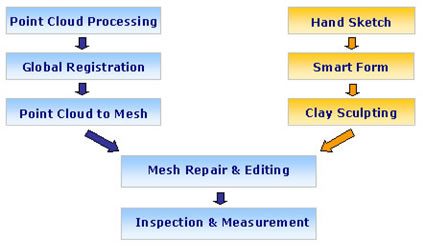
The VRMesh family consists of three packages designed for different usages and users:
- VRMesh Studio, a point cloud processing and mesh modeling environment for industry users requiring reverse engineering tools and design communication: $895.
- VRMesh Reverse provides a complete reverse engineering workflow for users to wrap point cloud data into an accurate meshed model: $695.
- VRMesh Design is for stereolithography (STL) repair and conceptual design: $495.
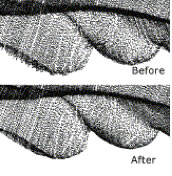 VRMesh v4.1’s denoising algorithm removes noisy data with high accuracy. |
Version 4.1 enhancements include faster point cloud smoothing and decimation, an improved point cloud to mesh command to reduce flipped regions in the high-noise level, the sketch and solid-cut command is changed to keep both parts, and the cross-section curve commands can generate multiple curves while many parts are intersected with the same plane. Plus, an improved interface allows precise manipulations of a virtual camera.
Point Cloud Processing
VRMesh can quickly clean up large-sized point clouds, remove extraneous points, automatically align multiple scanning patches together, and generate cross-section curves directly on point clouds. It fully supports vertex color through the processing, and an advanced decimation algorithm accurately preserves the critical data and removes redundant or unnecessary points. VirtualGrid says the software’s denoising algorithm produces highly accurate output.
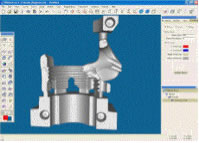 In one click, VRMesh v4.1 automatically triangulates point clouds to meshes. |
Registration & Triangulation
VRMesh offers fully automated reverse modeling processing to let users create an accurate polygonal model from multiple scans within a one-click wizard. Scan Registration Tools offers 1-point and n-point manual registration, global registration, target (from source to target) registration, and automatic multiple scan simplifying and merging.
Mesh Healing & Editing Tools
VRMesh also provides comprehensive mesh healing and editing tools for users to quickly build up high-quality meshed models. The company says the software’s advanced remesh smoothing, hole filling, and object-merging techniques make rapid prototyping tasks easier and more effective.
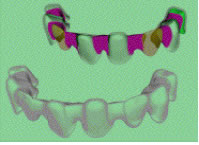 The Glue function in VRMesh merges multiple objects into one watertight model. |
“VRMesh is a point cloud and mesh processing software including many innovative technologies built from the ground up,” said Chao Han, the president and founder of VirtualGrid. “It delivers comprehensive and affordable solutions to engineers in the 3D scanning and printing industries.”
Fast Design from Sketch
Other features in VRMesh are smart form and Digital Clay. The sketch-based smart form techniques dramatically accelerate the transition from 2D sketches to 3D models. The digital-clay tools allow users to sculpt meshes on the fly.
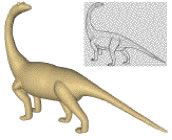 Smart Form and Digital Clay speed up the conceptual design process. |
In its literature, VirtualGrid describes VRMesh’s features as cutting-edge technologies. It is referring to a host of capabilities: the point cloud processing tools, the global point clouds/meshes registration process, its ability to triangulate point clouds to meshes automatically and accurately, the advanced hole-filling techniques, feature-preserving global/local remesh smoothing and decimation, advanced mesh-editing techniques (glue, fillet, knife, Boolean), sketch-based modeling techniques, and digital clay working directly on arbitrary triangle meshes.
Plus, VRMesh can handle large datasets by using Level-of-Detail display. The program has no limit concerning point clouds and mesh size, and it supports all 3D digitizers, cameras, and scanners in XYZ or ASCII format, handling ordered and unordered surface and volume data.
VRMesh, with complete organic details and solids, is said to offer an entire inspection and measurement solution. Plus, it is compatible with 32-bit applications running on 64-bit systems (including Vista x64).
On VirtualGrid’s VRMesh Library web page, the company says it welcomes inquiries from hardware developers who need 3D geometry processing for their captured 3D point data. The library, written in C++, compiled as DLL file, and compatible with Microsoft Windows, includes a set of triangle meshing, and mesh healing and editing technologies, which are adaptable for commercial products, custom applications, and co-development projects. The site also offers tutorials, a free upgrade, and a quick video featuring highlights.
Go directly to VirtualGrid.
Why DE’s editors chose VRMesh v4.1 as a Pick of the Week.
See a comparison chart of the VRMesh applications.
Download the VRMesh Product Brochure for a list of the software’s features.
Visit the VRMesh Library.
Read the company’s overview on VRMesh.
Download the VRMesh v4.1 demo.
Access the VRMesh v4.1.2 free upgrade.
Read the review, “VRMesh Is Like Digital Glue” by Mike Hudspeth, which appeared in April 2008 in Desktop Engineering:
Subscribe to our FREE magazine, FREE email newsletters or both!
About the Author
DE’s editors contribute news and new product announcements to Digital Engineering.
Press releases may be sent to them via [email protected].






